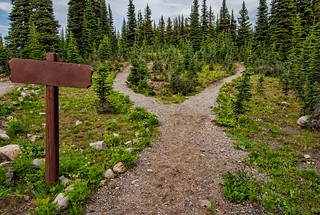My trek from geeky highschool student to Associate Director at the Center for Teaching Development at the University of California, San Diego has definitely followed the alternative academic career path.
When I finished my Ph.D. at the University of British Columbia in Vancouver, I jumped off the tenure track to teach math at a 2-year college in Vancouver. A few years later, I stepped halfway back into the Ivory Towers when I split my time between teaching introductory astronomy (#astro101) in the Department of Physics and Astronomy at UBC and being the resident astronomer at the H.R. MacMillan Space Centre (aka, the Planetarium) in Vancouver. I eventually ended up full-time in Physics and Astronomy at UBC, not on the tenure track but as a Science Teaching and Learning Fellow in the Carl Wieman Science Education Initiative. (Is there an adverb-form for gobsmacked or mind-blown? Oh well…) Gobsmackedly, I was in the office across the hall from where I’d first met my M.Sc. supervisor, Bill Unruh, some 18 years earlier. Now, I’m a faculty member in the Center for Teaching Development at UCSD, with the rank of Academic Coordinator.
Never have I been on the tenure track. Never have I been able to put “Professor” on my business cards.
And because of that, I have one regret (one is enough for this post): I’ve never felt the satisfaction and pride of having a graduate student. Because that’s what professors do, to move their disciplines forward. It’s their shoulders that the grad students stand upon to see further. When I hear from colleagues about the success of their students, I feel a wave of regret.
This summer that wave was reduced to a twinge.
Part of my job at UCSD is to teach a class called The College Classroom about teaching and learning to graduate students and postdocs. Some of the graduate students become Summer Graduate Teaching Scholars (SGTSs) and teach a course in the Summer session. As part of our ongoing support, I observe each SGTS’s class 2 weeks into the 5-week marathon and give them some formative feedback.
And it was there, sitting in the back of those classes, that my wave of regret was reduced to a twinge. This summer, I witnessed first-time-ever instructors
- running flawless peer instruction with clickers
- drawing out students’ preconceptions and immediately integrating them into the lesson
- creating a supportive learning environment where students feel free to discuss their personal, sometime quite, experiences
- make every single one of the 5o students in the room feel like they have a critical contribution to make to the class
- ask the perfect question to ignite a conversation that experts in the field would have
Sometimes I sat there thinking, “Seriously? How did she know to do that? Awe. Some.”
Can I take all the credit? No, of course not, no more than a supervisor can take all the credit for grad student producing a succesful thesis. But I definitely had a role to play and, man, does it feel good.
And, so, what about my circuitous trek through higher ed? No regrets.
Postscript
If you find yourself on a alternative academic path or you’re approaching the fork between tenure-track and not tenure-track, get on Twitter and follow the #altac hashtag. There are many others like you struggling with the same decisions you’re making.


 Within 30 seconds of me saying, “Well?”, they’d taught each other that this was a sunset. It went something like this:
Within 30 seconds of me saying, “Well?”, they’d taught each other that this was a sunset. It went something like this: